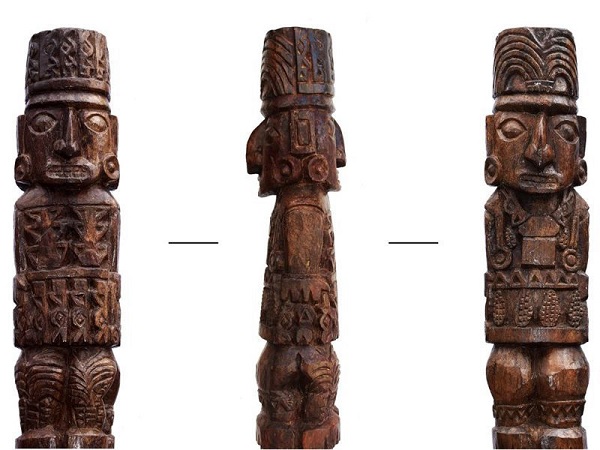
In 1533 Hernando Pizarro completed his conquest of Peru, and destroyed many symbols of the Inca Empire’s royal dynasty and religion. He ordered that the people break open the vault containing the giant wooden statue of Pacha Kamaq (“Earth Maker”), father of the popular goddess Pacha Mama (“Earth Mother”), and destroy its idol, which the Incan people had consulted as an oracle and purportedly was stained red by the blood of human sacrifices.
Until last week, it was generally assumed this order had been carried out.
Pacha Kamaq always fitted rather uneasily into the pantheon of the Incas, who generally regarded Viracocha of the shining face as the creator of all things, and Inti the Sun as the main focus of worship. Among the persistent pre-Conquest features of Peruvian folk religion, he played little role except for occasionally appearing in artwork. Pacha Mama, however, has always remained important.
The offering to her, challaco (“sprinkling” in the Quechua language), usually consists of pouring a little corn liquor into the ground (or dropping some food if the drink is not available), as a morning ritual, or to open a meeting or festival, or whenever passing an apacheta (cairn of stones marking a mountain trail). On Mardi Gras, guinea pigs and sometimes baby llamas were sacrificed, or cloth figures are woven, dyed and ceremonially burned. In early August (midwinter in the southern hemisphere, when people are most at risk of illness), a hearty dish tijtincha of corn and beans with boiled jerky or cheese or whatever seems good is prepared, but some must be thrown into a stream for Pacha Mama.
In October 2019 Pope Francis dedicated a Synod to the Amazon, expressing solidarity with the indigenous peoples there threatened by Brazilian President Jair Bolsonaro. Bolsonaro denies any role in the many fires set in the rain forest, but makes no secret of his desire to see the forest cleared for cattle ranching and other economic exploitation, or of his contempt for the indigenous people. Francis blessed figurines from the upper Amazon of Pacha Mama, in the form of a kneeling, naked, pregnant woman, as “an image of motherhood and the sacredness of life, a traditional symbol for indigenous peoples representing the bond with our ‘mother earth,’ as described by Saint Francis of Assisi in his Canticle of the Creatures” while denying any attempt to identify the figure with the Virgin Mary.
Conservative Catholics were enraged and appalled at what they view as clear idol worship, potentially demonic in nature if the cult of this goddess was rooted in child sacrifice.
In a rare gesture of rebellion, Father Hugo Valdemar of Mexico City burned wooden panels painted to resemble the Pacha Mama figurines, asking the Virgin of Guadalupe for atonement for the veneration in Rome of what he called a parody of the Blessed Virgin, intended by the “Masonic Church” to give birth to the Antichrist.
The site where Pacha Mama’s father was worshiped was still remembered and called Pachacamac (in the older transcription style). It contains three large pyramids, and in the one called the “Painted Temple” archeologists in 1938 found an eight-foot wooden statue. (See image at the top of the page.) This was thought to be a replica of the destroyed idol, and possibly not even faithful to the appearance of the original, since artistic depictions of Pacha Kamaq often showed him with bird’s beak and wings.
When radiocarbon dating was invented in the 1950s it required destruction of a large amount of organic material, unsuitable for an artifact like this. But techniques have greatly advanced, and a new study was able to nail down its age for the first time.
The Pacha Kamaq, according to a study published January 15, dates to 760-876, in the “Middle Horizon” period of the Wari Empire.
The Wari fell centuries before the Inca re-established a united state in Peru, and until recently some questioned whether it was really an “Empire” at all, or just a trading network of culturally related sites. Then in 2013 a mausoleum was excavated, which despite centuries of looting in surrounding burial sites, was intact with about 60 bodies dressed in the remains of fine textiles, surrounded by items made of gold, silver, and precious stones. There are signs that some of the bodies were taken outside from time to time for public display, before the mausoleum was sealed under tons of stone rubble.
The Pacha Kamaq idol was made near or even before the foundation of this dynasty, between the early formative period and the full flourishing of Wari. X-ray fluorescence revealed traces of pigment: the teeth were once painted white, the headdress yellow, and the body red, using cinnabar (a mercury ore). The white and yellow could be made locally, but the nearest cinnabar was 250 miles away, so the state already had some reach.
We can acquit the Pacha Kamaq cult of the lurid accusation of painting their statue with blood, but perhaps not of being associated with child sacrifice. The largest cases known in Peru, grisly mass graves with 140 and 227 children, were from a different culture, the Chimu who controlled part of the coast in the interregnum between the Wari and Inca realms, and worshipped Shi the Moon rather than the Earth or Sun. The mass slaughters appear to have been a desperate response to catastrophic floods, not a regular practice. However, it may be significant that many of the victims were smeared with cinnabar.
Robert Eckert is a longtime member of the Underground Bunker community and author of the historical novel The Year of Five Emperors.






